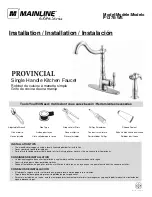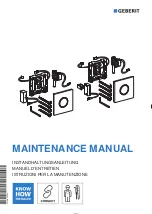
7
114107-2-
CA
(B)
Kohler Co., Kohler, WI
TROUBLESHOOTING CHART
SYMPTOMS
PROBABLE CAUSES
CORRECTIVE ACTION
1. Float valve
turns on/off
by itself
without
toilet being
flushed.
A. Refill tube pushed too far down in overflow
pipe.
B. No slack in flapper chain assembly, holding
flapper off seat.
C. Flush valve flapper ball worn, dirty or
misaligned with flush valve seat; or seat
corroded so flapper will not seal.
A. Attach refill tube to overflow pipe above the
water line.
B. Adjust flapper chain assembly between float
mechanism and trip lever arm for proper slack.
C. Inspect, clean, and if necessary, replace flapper
ball and/or seat.
2. Float valve
continues
to run,
allowing
water to
enter tank.
A. Foreign particles lodged under the float valve
seal (located under float valve cap).
B. Float valve seal (located under float valve cap)
may be cracked or split.
C. Chain is tangled or caught on float mechanism.
A. Shut off water supply; remove float valve cap
assembly by rotating 1/8 turn counterclockwise.
Cover uncapped lower valve unit with an
inverted cup (holding it to prevent overspray),
and turn water on and off a few times. Clean
float valve seal surface (located under float
valve cap). Replace float valve cap assembly by
engaging lugs and rotating 1/8 turn clockwise.
Turn water on.
Install supply line filter to prevent recurring
problems.
B. Replace seal.
C. Free float mechanism.
3. Incorrect
water level
height.
A. Valve float cup does not contain enough water
to provide required ballast.
A. During fill cycle, hold float under water a few
seconds to allow it to fill with water ballast. See
Page 5.
4. Long or
noisy tank
fill cycle.
A. Plugged valve inlet or supply line.
A. Perform Corrective Action 2.A.
5. Poor flush.
A. Use of 1.1 gallon flush trip handle for solid
waste removal.
B. Trapway or rim holes are obstructed.
C. Soil pipe or vent is obstructed.
D. Low water level in bowl due to refill tube being
plugged or out of overflow tube.
E. Supply shut-off valve not fully open.
A. Actuate 1.6 gallon handle for maximum flushing
performance (1.6 gallons).
B. Unclog trapway; clean rim holes.
C. Clear obstruction from soil pipe or vent.
D. Clean or straighten refill tube; attach refill tube to
overflow tube.
E. Open supply shut-off valve.
6. Toilet
overflows.
A. Toilet trapway is obstructed.
B. Soil pipe or vent is obstructed.
A. Use plunger to unclog.
B. Clear obstruction from soil pipe or vent pipe.
7. Toilet does
not
activate.
A. Chain is not connected to lift rod, flush valve,
flapper, or float mechanism.
B. Too much slack in chain between trip arm and
cam on dual flush mechanism.
A. Reconnect the chain.
B. Adjust slack in 1.6 gallon flush chain for proper
operation. See Page 6.
Adjust slack in 1.1 gallon flush chain for proper
operation. See Page 6.
8. Short flush
does not
activate.
A. Cam on flush valve float assembly does not
activate properly.
A. Check chains for free movement between float
mechanism and trip lever arm. Untangle chains
as needed.
Adjust slack in 1.1 gallon flush chain for proper
operation. See Page 6.
9. Long flush
does not
activate.
A. Cam on flush valve float assembly does not
activate properly.
A. Check chains for free movement between float
mechanism and trip lever arm. Untangle chains
as needed.
Adjust slack in 1.6 gallon flush chain for proper
operation. See Page 6.
10. Poor
handle
alignment.
A. Adjustment screw is not properly adjusted.
A. Turn handle adjustment screw to obtain
acceptable handle alignment – clockwise to
lower end of flush handle; counterclockwise to
raise end.


























